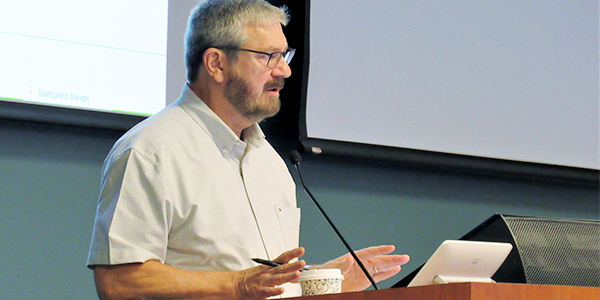By Amanda Durish Cook
CARMEL, Ind. — MISO plans to file its first storage-as-transmission asset (SATA) ruleset next month, despite complaints from some members that the proposed provisions limit resource ownership to transmission owners.
Speaking at a Sept. 25 Planning Advisory Committee meeting, DTE Energy’s Nick Griffin said he and others still see an “equality” issue with the ownership restriction. Griffin has told MISO’s Board of Directors that if the provision remains in the filing, DTE would file a protest in the docket arguing that similarly situated parties stand to be treated inequitably. (See MISO Firming Up 1st SATA Ruleset.)
Discussion at the PAC meeting quickly waded into murky waters over what it means to be a TO and what constitutes a transmission asset.
Griffin has suggested a compromise in which MISO allows non-TOs to own storage that provides reliability transmission services while simultaneously completing the approximately three-year interconnection queue to allow the asset to become a market-based generator. The resource would initially be classified as a transmission asset, then transition to a market resource.
“We can’t defer transmission unless we have an assurance that the transmission alternative” will be there, MISO Director of Planning Jeff Webb said. “If it’s built and constructed and goes into service — and it can’t participate in the market until it goes through the queue — what if it never goes through the queue? Who pays for that? Where are you going to get your cost recovery?
“That’s the fundamental problem we’re having: What is a transmission asset? This feels like a transmission asset owned by a non-transmission owner,” he said. “I’m really worried about the slippery slope here; it’s a gateway drug. The next question might be, ‘Hey, can I do this with a peaking gas generator?’ … We have to find a place for [SATA] that respects our framework.”
“I think already in this process there’s a lot of gray area between transmission and non-transmission assets [NTAs], and unfortunately, that’s where FERC has left us,” Clean Grid Alliance’s Natalie McIntire said. Part of the gray area stems from MISO not having a particularly clear definition of NTAs, she said.
“The dream I have is we would abolish the term ‘non-transmission alternatives’ and define it for what it is versus what it’s not,” Webb said.
MISO has one SATA project proposed for Wisconsin in this year’s Transmission Expansion Plan (MTEP), making the filing a bit of a race against the clock because the RTO doesn’t yet have cost recovery in place. (See MTEP 19 Could Yield First MISO SATA Project.)
Webb said it’s unlikely that FERC will rule on the SATA rules by the board’s approval of MTEP 19 in December. Because MISO doesn’t want to proceed with an uncertain project, it will likely formally recommend the storage project after the usual December timeline. PAC Chair Cynthia Crane said RTO planning staff can appear before the board at the March 2020 meeting to make a one-off recommendation for a project.
MISO last month began drafting SATA provisions to be included in its business practices manual covering transmission planning processes. The drafts place several mentions of electric storage resources into BPM 20, the existing rules on selecting NTAs in place of transmission projects. The provisions would add an inverter-based reliability analysis and allow the RTO to consider the life cycle, degradation and cost assumptions of storage resources, as well as the impacts on proposed generation in the interconnection queue. The changes would also require SATA operators to develop an operating guide for each asset approved in the MTEP process.
But MISO will now put the proposed BPM edits on hold, pending the outcome of the FERC filing, responding to the complaints of stakeholders who said they were premature. Several members said MISO shouldn’t create BPM provisions before defining a method for evaluating SATA projects.
“The BPM was a vehicle to vet changes,” Webb said, explaining the BPM is subject to revision to align with whatever version of Tariff revisions FERC accepts. He said the minimal BPM edits are simply the “essential features” to implement SATA.




